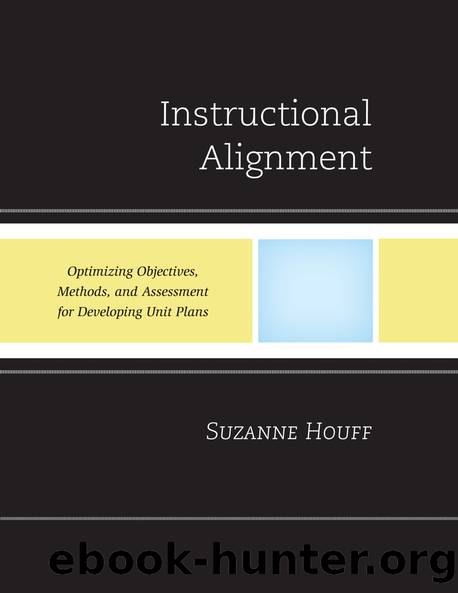Instructional Alignment by Houff Suzanne;

Author:Houff, Suzanne; [Houff, Suzanne]
Language: eng
Format: epub
Publisher: R&L Education
Published: 2012-08-15T00:00:00+00:00
Mr. Will should have specific objectives and goals that he uses to guide his instruction. Assessment is based on preestablished goals. Students need to know the expectations and criteria they need to meet in order to pass.
What other criteria do you think Mr. Will can implement into his PE classes to help with his final grades?
He needs to look at state or core standards and determine what the students should know and be able to do. He can then base assessment on that. He also needs to offer a variety of assessment strategies.
Elm Tree
Mrs. Johnston is in her second year of teaching sixth grade at Elm Tree Elementary School. She is an effective teacher to her class of twenty-three students. She strives to meet their individual needs.
Three of the students have been diagnosed with a learning disability. Two of these three have been diagnosed with ADHD. The other student is dyslexic and works with a reading and writing specialist.
The school is located in an urban area, with almost 50 percent of the class living in low-income housing and receiving free or reduced lunch. The class is generally well behaved, yet at times the students get distracted by the few who may have a hard time staying in their seats or are talking too much.
Mrs. Johnston gives very little homework. She found in her first year of teaching that homework assignments were rarely completed. This only caused her frustration. She finds little time in her schedule to cover geography. With an emphasis on reading, writing, and math, it is hard for her to find the time in the day to spend on social sciences. The school is struggling to make AYP, so she feels like she needs to concentrate on the things her administration asks her to focus on. Mrs. Johnston, like most teachers, also has to deal with all the administrative tasks, classroom procedures, and behavior interruptions.
However, she did find time to teach a map geography unit in her class, covering cardinal directions, scale, and symbols. She began the unit by dividing the class into cooperative groups. Each group developed a map of the classroom. They turned these in to her and she reviewed them as a means of formative assessment. All groups seemed to understand the assignment. There were only a couple of groups missing two or three things. She briefly went over these items with the class as she handed back the maps and moved on to the next topic.
She finished teaching the unit and a test was given. The test included identifying the parts of the map and creating a map of their dream bedroom. After she collected and graded the tests, only fifteen out of twenty earned a C- or better and only five of these students received an A. She was surprised that all of the students did not earn a C or better.
Mrs. Johnston shared her concerns with another sixth-grade teacher who used similar lesson plans and a similar test. This teacherâs class did considerably better on the assessment.
Download
This site does not store any files on its server. We only index and link to content provided by other sites. Please contact the content providers to delete copyright contents if any and email us, we'll remove relevant links or contents immediately.
Deep learning with TensorFlow and Keras by Derrick mwiti(830)
Understanding PDA Autism in Kids: A Guide for Parents and Teachers to Support Neurodiverse Learners by Jehu Len(584)
The Victorian Era: A Captivating Guide to the Life of Queen Victoria and an Era in the History of the United Kingdom Known for Its Hierarchy-Based Social Order by Captivating History(448)
Brain Teasers to Build Critical Thinking Skills by Safarova Kris(421)
Brain Teasers to Build Critical Thinking Skills: Brain Exercises for Tech, Banking, Case Interview Prep, and to Keep Your Mind Sharp by Kris Safarova(421)
100 Ideas for Secondary Teachers: Engaging Parents by Janet Goodall & Kathryn Weston(394)
Python 101 - Fundamentals by Sam(380)
Critical Curriculum Leadership : A Framework for Progressive Education by Rose M. Ylimaki(375)
Writing Solid Code: Development Philosophies for Writing Bug-Free Programs by Steve Maguire(365)
Intersectionality in Educational Research by Dannielle Joy Davis; James L. Olive; Rachelle J. Brunn-Bevel; Susan R. Jones(345)
The Art of Emotional Validation: Improve Your Communication Skills and Transform Your Relationships by Validating Emotions and Feelings by Emily Wright(342)
The Knights Templar: An Enthralling History of the Rise and Fall of the Most Influential Catholic Military Order by Wellman Billy(338)
A Beginner's Guide to SSD Firmware by Unknown(334)
The Future Knowledge Compendium by Ellyard Peter;(325)
How to be assertive in any situation by Hadfield Sue & Hasson Gill(320)
Making Connections in and Through Arts-Based Educational Research by Hala Mreiwed Mindy R. Carter Sara Hashem Candace H. Blake-Amarante(316)
What Every Teacher Should Know about Learning, Memory, and the Brain by Tileston Donna E. Walker;(314)
Foundations of Educational Research by Victoria Elliott(310)
Message from the Pleiades; The Contact Notes of Eduard Billy Meier v1 only by unknow(307)
